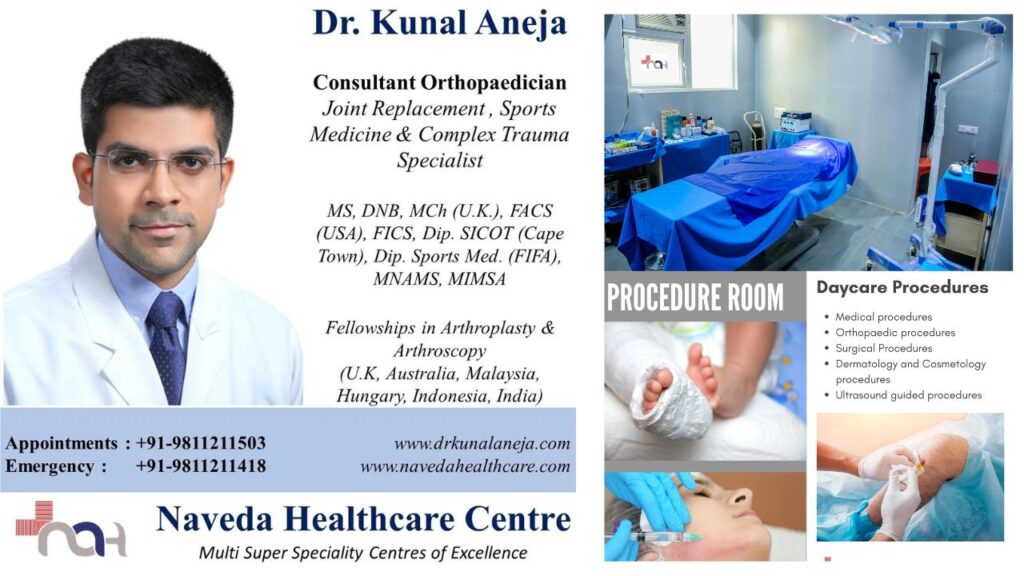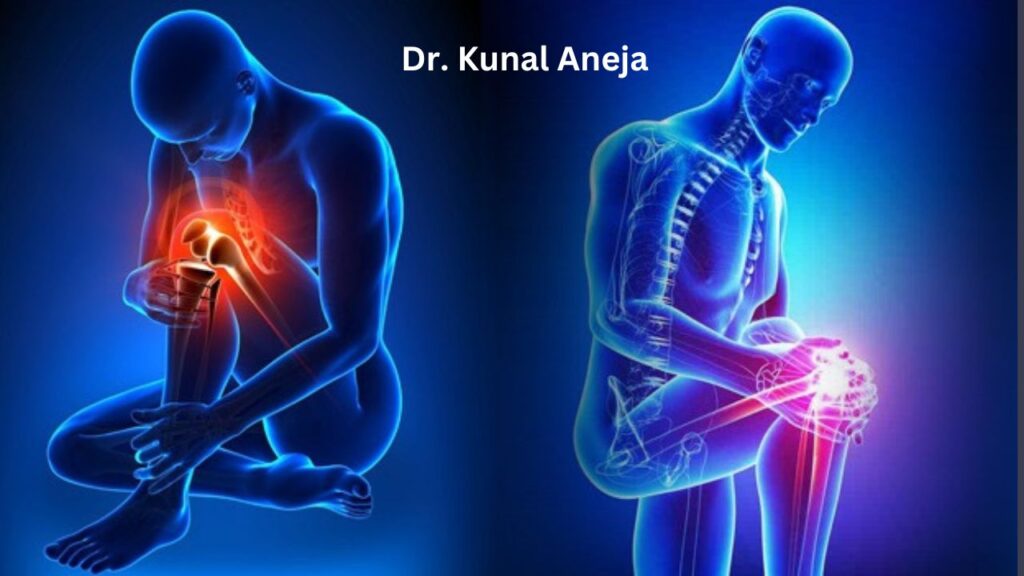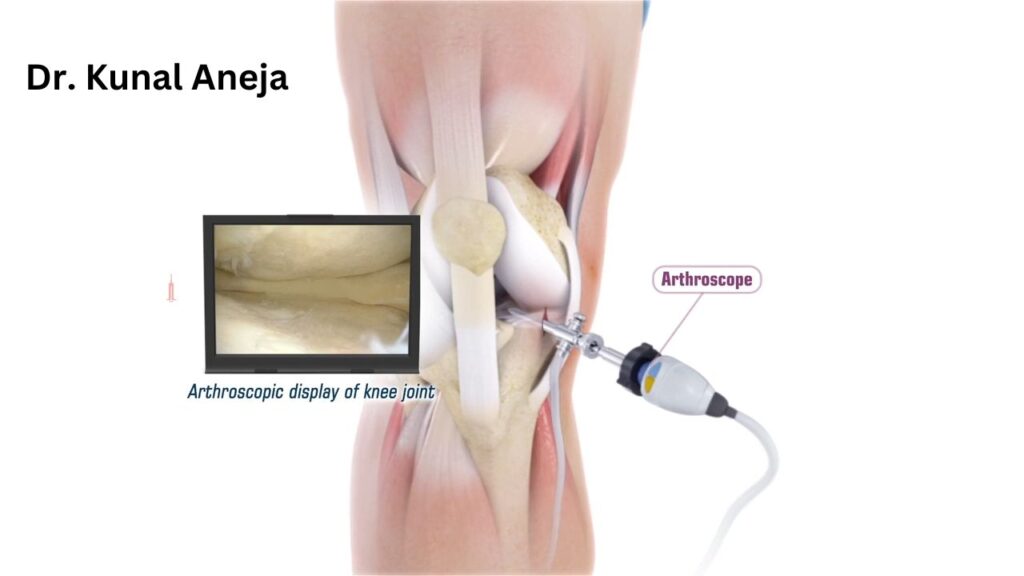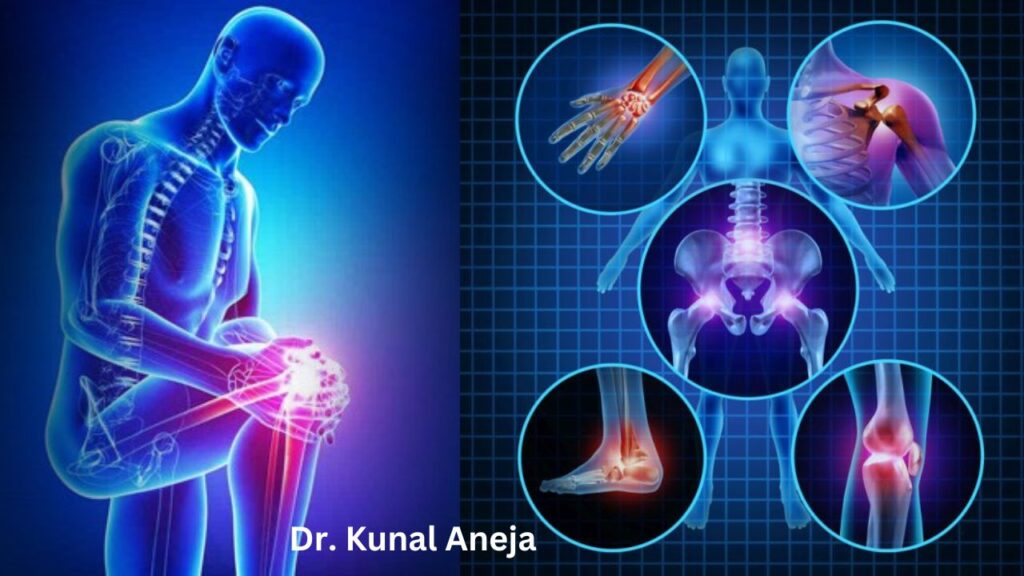
The best orthopedic doctor in delhi is Dr. Kunal Aneja. In addition to treating complex and unusual orthopedic cases, he provides non-surgical orthopedic care for patients of all ages. He is the best orthopedic surgeon in Delhi, so he treats a wide range of orthopedic problems. He provides the best and most accurate treatment solutions for acute injuries, such as broken bones, torn ligaments, back pain, shoulder problems, hip problems, etc. An orthopedic specialist in Delhi, he specializes in treating severe injuries requiring complex reconstruction. Patients with long-term complications such as arthritis and nerve compression receive effective and efficient treatment.
Knee injuries
It is essential to understand the anatomy of the knee.
Three bones are connected through the joint at the knee, which is called the kneecap or patella. The femur is the thigh bone, the tibia is the leg bone, and the patella is the knee cap. When the thigh and leg bones glide over each other, they facilitate load (bearing weight) on the knee and motion. During the knee cap (patella) movement, a groove known as the trochlea (concave portion) on the thigh bone is located over the cave part, which slides over the patella.
Muscular Anatomy:
As the thigh muscles (quadriceps mechanism) are attached to the knee cap on its upper aspect, the rope-like structure that attaches it to the leg bone acts as a lever to facilitate knee joint movement. This mechanism acts as a lever and facilitates the movement of the knee joint. To bend the knee, the quadriceps muscle, the patella, the fulcrum, and the patellar tendon are all involved in bearing the load of moving the leg over the thigh bone.
Soft Tissue Anatomy:
A 1 cm thick layer of polish is applied to all three bone surfaces called cartilage that covers them all. This means that very little friction occurs during movement. Additionally, there are two ‘C’ shapes of cushions between the thigh and leg bones, one on either side of the knee and one on the outside. In the same way that shock absorbers do in a bike, these act as shock absorbers by reducing the load directly transmitted to the cartilage and bone. There are four ropes called ligaments that provide support to both the thigh and leg bones, enabling them to be stable together.

Ligaments:
One on the inside: medial collateral ligament (MCL)
One on the outside: lateral collateral ligament
Two in the center crossing each other: Anterior and posterior cruciate ligaments
A broad classification of these can be made as follows:
1. Bony
2. Soft Tissue
Bony Injuries:
A fracture of the femur, tibia or patella causes an open fracture. If the bone breaks into two pieces (simple fracture), or multiple pieces (comminuted fracture), it is called an open fracture. Open fractures can be associated with wounds of varying sizes that communicate with the fracture, but if the wound does not communicate with the fracture, it is referred to as a closed fracture. Sometimes a bone will break at a place where ligaments or tendons are attached to it. These injuries are known as avulsion injuries. Some types of fractures are minimally displaced/undisplaced if the pieces have not moved much from their original location, and fractures that have moved from their original location are called displaced fractures if they have moved far from their original location. In the case of fractures that communicate with the joint, they are referred to as intraarticular fractures, and those that do not are called extraarticular fractures.

Diagnosis:
Typically, a patient will suffer an antecedent injury followed by pain, an inability to move the limb, swelling and deformity. Usually, x-rays are taken of the part, including the joint above and below the injury, to confirm the diagnosis. If the fracture is not visible on an X-ray, like an undisplaced crack fracture, then a CT scan will be required to determine the cause of the fracture.
Treatment:
To determine the best treatment for a fracture, it is essential to consider its nature, location, and displacement.
Injuries to the soft tissues
Injuries to the ligaments include:
ACL/PCL :
When the thigh bone moves forward, the anterior cruciate ligament prevents the leg bone from moving forward on the thigh bone. As a result, this ligament tends to get injured when the knee is hyperextended or twisted during a sporting activity or bike accident. There are several ways the ligament can tear off from its attachment on the thigh bone, through its middle or its attachment on the leg bone.
Treatment:
People with low-key injuries can be treated conservatively with rehabilitation. People with associated meniscus tears or those looking to live an active lifestyle must have the ligament repaired or reconstructed.
As part of this procedure, spare tendons in the body, such as the patellar tendon and hamstring tendons, are harvested and prepared to form new ligaments. Drilling tunnels into the leg and thigh bone are used to place the new ligaments into the knee. A button is attached to the thigh bone, and a screw (plastic) is attached to the leg bone to hold it in place.
Occasionally, arthroscopic techniques can be used to repair ligaments that have avulsed from the thigh or leg bone.
MCL/LCL Tear:
An excessive sideward movement of the leg bone can cause these ligaments to break through their mid-substance and attachments at either end. They can break through their mid-substance and attachments at either end.
Treatment:
Ligament injuries through the substance or attachments through the thigh bone tend to heal more quickly without surgery. However, persistent instability warrants surgery/reconstruction. Operative treatment is essential when associated with another ligament injury or meniscus injury.

Meniscus Injuries
There is a tendency for the meniscus to tear alone or in conjunction with ligament tears.
As the patient ages, they may tear spontaneously (degenerate).
An injury-related tear can be treated by either partially removing the meniscus or by repairing the meniscus with keyhole (arthroscopic) techniques. Unless mechanical symptoms like something gets stuck in the knee or locked, degenerative tears are usually treated without surgery.
Orthopedic Doctors & Surgeons in Delhi – Dr. Kunal Aneja
Dr. Kunal Aneja is the best Orthopaedic Doctor & Surgeon in Delhi. Book appointments with Dr. Kunal Aneja, an expert orthopedic surgeon at Naveda Healthcare Centre.

